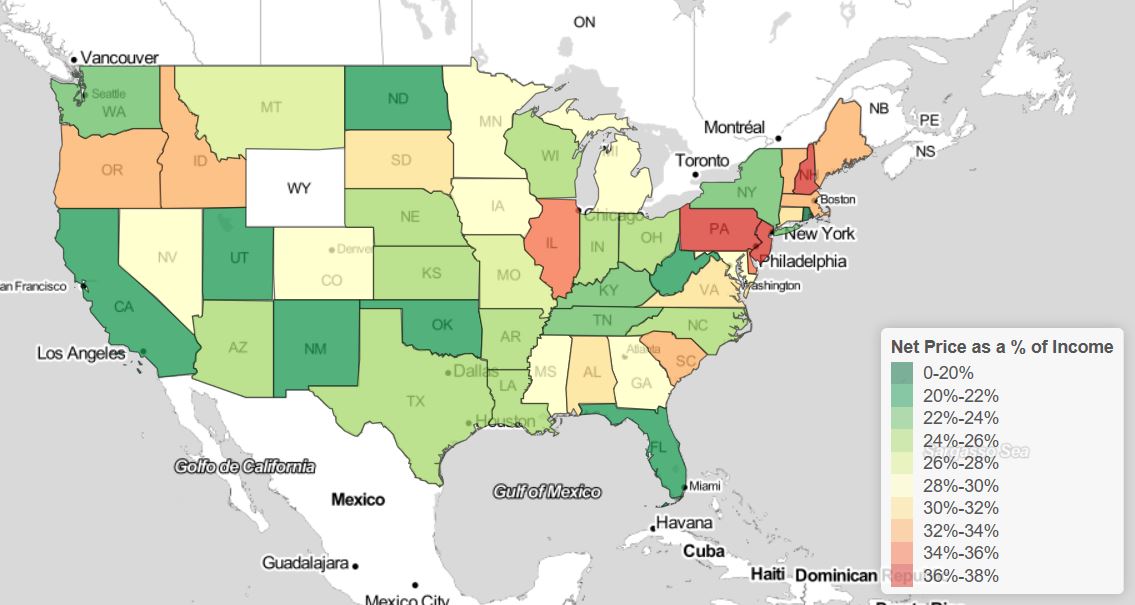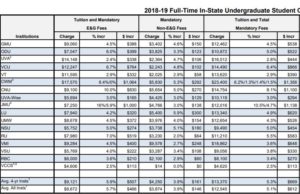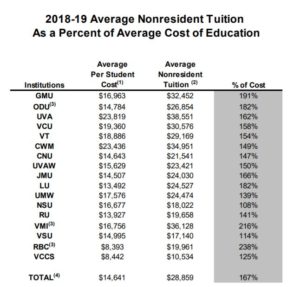
Cost of attending a four-year state college as a percent of household income. Click for interactive version. Sources: Penn and Vanderbilt
Tuition and mandatory fees at Virginia’s state colleges and universities are rising an average of 5.3 percent for the term starting next month, eighty percent faster than inflation. The increase at the state’s community colleges for next term of 2.5 percent tracks well behind the current 12-month consumer price index (2.9 percent).
The report is contained in advance materials for the July 17 meeting of the State Council of Higher Education in Virginia. Director Peter Blake reports tuition and fees will increase by an average of $669 at four-year institutions and $113 at Virginia’s community colleges under charges set recently by the institutions’ governing boards. Increases range from $330 at Virginia State University to $1,100 at Christopher Newport University. “The systemwide increase is slightly higher than the increases in the previous two years,” he wrote.
Looking at tuition alone, the average increase is just under 6 percent, but smaller growth in mandatory fees softens that a bit. Four years at the College of William and Mary will cost a new freshman paying the full freight almost $94,000 (before room and board), but at that school each incoming class’s in-state tuition rate is fixed for four years. A new in-state student at the University of Virginia will need at least $66,000 for four years but may face three more tuition hikes before graduation.
Christopher Newport University in Newport News had the largest overall increase on a percentage basis, 8.1 percent, and the new cost of four years there for new in-state students is $59,000 (again, with further increases likely.)
Out-of-state students pay substantially more in tuition than the cost of their education, according to another chart in the SCHEV data. It is more than double at some schools, and close to double at others. The pattern between Virginia and William and Mary reverses, with Virginia charging the higher premium for non-Virginia residents.
The state provides more than $2 billion annually from taxpayers as direct support for the schools or financial aid for individuals. The General Assembly increased General Fund support for the schools by more than $165 million in the new budget, but with most of the additional dollars in the second year of the budget starting July 2019. The increase for the coming school term for operations and aid was a modest $17 million. Much of the new money over the period is going to things unrelated to classroom instruction.
On Friday SCHEV sent out a news release focused on University of Pennsylvania data showing that Virginia’s higher education system faces lower risk than almost all other states. Whether that is because of Virginia’s strength or weaknesses in other states is unclear. It still warned Virginia’s population would not have the needed number of degree or certificate holders by 2025.
Virginia’s 4th graders were highly-ranked compared to other states on the National Association of Educational Performance but only 47 percent were proficient or better in mathematics, and 43 percent proficient or better in reading. By 8th grade those were down to 38 and 36 percent. In four years those 8th graders are the college admission pool.
The Penn report ranked Virginia 41st on affordability. It included interactive charts comparing the affordability of state systems across the country by comparing costs to average household incomes. Cross-referencing the recent CNBC business network’s Best States for Business ranking, Virginia and Massachusetts had the highest costs on that basis among the top ten states, at 32 percent of household income. Five of the ten had costs at or below 25 percent of household income, with Florida the lowest at 20 percent.
Virginia’s community colleges, which are seeing significant enrollment declines, cost only 17 percent of average household income. That is right in line with most of the other top-ten states in CNBC’s list, with Colorado and Minnesota the most expensive for two-year degrees.
A debate continues to rage over whether rising school costs are driving away students, but the Virginia schools under the largest enrollment pressure, the community colleges and the two historically-black institutions, stand out in the SCHEV data lower overall costs, lower cost increases, and lower mark-ups for out of state students.




